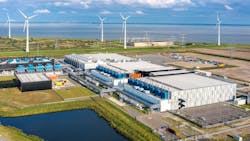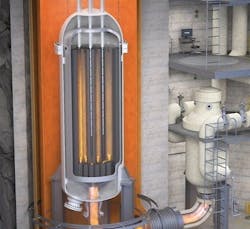Elementl Power Contracted to Find Nuclear Power Sites for Google
Tech giant Google is going to work with energy project developer Elementl Power on empowering the latter to determine locations for advanced nuclear and small modular reactor (SMR) sites to power its fleet of data centers.
Google is committing early-stage development capital to advance work on three projects. Each of those will be designed to generate a minimum of 600 MW of carbon-free nuclear energy capacity.
Elementl Power, which was founded only three years ago, has announced a goal of bringing new nuclear capacity online by 2035. Data center hyperscalers such as Google, Microsoft and Amazon Web Services are seeking baseload, continuous and carbon-free power—which matches nuclear’s generation attributes—to fuel the growth of artificial intelligence (AI) and cloud-based capacity.
"Google is committed to catalyzing projects that strengthen the power grids where we operate, and advanced nuclear technology provides reliable, baseload, 24/7 energy," said Amanda Peterson Corio, Global Head of Data Center Energy at Google, in a statement. "Our collaboration with Elementl Power enhances our ability to move at the speed required to meet this moment of AI and American innovation."
Forecasts by McKinsey & Co, Bloom Energy and others are predicting up to 50 GW of new data center capacity being online by the early 2030s. This growth in AI and cloud-based facility load is outpacing utility power generation in its current form.
Companies which are working on advanced nuclear and other small reactors include NANO, X-energy, Natura Resources, NuScale Power, GE Hitachi, Westinghouse, TerraPower and Oklo, among others. The U.S. Nuclear Regulator Commission has approved the design permit applications for some SMR startups, but no project has entered the construction phase yet.
Google parent Alphabet is one of world’s largest companies with $350 billion in annual revenue and a market capitalization of about $1.5 trillion. The Google search engine has the world’s largest market share, by far, and handles close to 8.5 billion searches per day, according to reports.
The company also has pursued other clean energy power purchase deals, such as a $20 billion agreement with developer Intersect Power and investor TPG Rise. That PPA focused on several gigawatts of new data capacity energized by future renewable resources and energy storage.
Research by the National Renewable Energy Laboratory this past year estimated the capital expenditure cost of a 300-MW nuclear project at between $6.4 billion to $12 billion. A conventional or utility-scale nuclear project like the Vogtle 3 and 4 expansions in Georgia ended up costing more than $30 billion over a decade of construction.
Some companies, such as Microsoft, are pursuing a reopening of retired units such as its deal with Constellation and Three Mile Island’s Reactor 1 in Pennsylvania.
Under the deal with Google, Elementl Power would evaluate technologies, engineering, procurement and construction of future nuclear projects, while also prioritizing specific sites for accelerated development.
About the Author
Rod Walton, EnergyTech Managing Editor
Managing Editor
For EnergyTech editorial inquiries, please contact Managing Editor Rod Walton at [email protected].
Rod Walton has spent 17 years covering the energy industry as a newspaper and trade journalist. He formerly was energy writer and business editor at the Tulsa World. Later, he spent six years covering the electricity power sector for Pennwell and Clarion Events. He joined Endeavor and EnergyTech in November 2021.
Walton earned his Bachelors degree in journalism from the University of Oklahoma. His career stops include the Moore American, Bartlesville Examiner-Enterprise, Wagoner Tribune and Tulsa World.
EnergyTech is focused on the mission critical and large-scale energy users and their sustainability and resiliency goals. These include the commercial and industrial sectors, as well as the military, universities, data centers and microgrids. The C&I sectors together account for close to 30 percent of greenhouse gas emissions in the U.S.
He was named Managing Editor for Microgrid Knowledge and EnergyTech starting July 1, 2023
Many large-scale energy users such as Fortune 500 companies, and mission-critical users such as military bases, universities, healthcare facilities, public safety and data centers, shifting their energy priorities to reach net-zero carbon goals within the coming decades. These include plans for renewable energy power purchase agreements, but also on-site resiliency projects such as microgrids, combined heat and power, rooftop solar, energy storage, digitalization and building efficiency upgrades.


